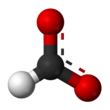This is an old revision of this page, as edited by Luckas-bot (talk | contribs) at 08:36, 3 April 2011 (r2.7.1) (robot Adding: es:Formiato de sodio). The present address (URL) is a permanent link to this revision, which may differ significantly from the current revision.
Revision as of 08:36, 3 April 2011 by Luckas-bot (talk | contribs) (r2.7.1) (robot Adding: es:Formiato de sodio)(diff) ← Previous revision | Latest revision (diff) | Newer revision → (diff) | |||
| |||
| Names | |||
|---|---|---|---|
| Other names formic acid, sodium salt | |||
| Identifiers | |||
| CAS Number | |||
| 3D model (JSmol) | |||
| ChemSpider | |||
| ECHA InfoCard | 100.004.990 | ||
| EC Number |
| ||
| E number | E237 (preservatives) | ||
| UNII | |||
| CompTox Dashboard (EPA) | |||
InChI
| |||
SMILES
| |||
| Properties | |||
| Chemical formula | HCOONa | ||
| Molar mass | 68.01 g/mol | ||
| Appearance | white granules deliquescent | ||
| Density | 1.92 g/cm (20°C) | ||
| Melting point | 253 °C | ||
| Boiling point | decomposes | ||
| Solubility in water | 97 g/100 mL (20°C) | ||
| Solubility | insoluble in ether soluble in glycerol, alcohol | ||
| Acidity (pKa) | 7.0-8.5 (0.1M) | ||
| Hazards | |||
| NFPA 704 (fire diamond) |
 | ||
| Except where otherwise noted, data are given for materials in their standard state (at 25 °C , 100 kPa).
| |||
Sodium formate, HCOONa, is the sodium salt of formic acid, HCOOH. It usually appears as a white deliquescent powder.
Uses
Sodium formate is used in several fabric dyeing and printing processes. It is also used as a buffering agent for strong mineral acids to increase their pH, and as a food additive (E237).
Preparation
Sodium formate can be prepared in the laboratory by neutralizing formic acid with sodium carbonate. It can also be obtained by reacting chloroform with an alcoholic solution of sodium hydroxide.
or by reacting sodium hydroxide with chloral hydrate.
- C2HCl3(OH)2 + NaOH → CHCl3 + HCOONa + H2O
The latter method is, in general, preferred to the former because the low aqueous solubility of CHCl3 makes it easier to separate out from the sodium formate solution, by fractional crystallization, than the soluble NaCl would be.
For commercial use, sodium formate is produced by absorbing carbon monoxide under pressure in solid sodium hydroxide at 160 °C.
Sodium formate may also be created via the haloform reaction between ethanol and sodium hypochlorite in the presence of a base. This procedure is well documented for the preparation of chloroform.
See also
References
| This article does not cite any sources. Please help improve this article by adding citations to reliable sources. Unsourced material may be challenged and removed. Find sources: "Sodium formate" – news · newspapers · books · scholar · JSTOR (September 2007) (Learn how and when to remove this message) |
This inorganic compound–related article is a stub. You can help Misplaced Pages by expanding it. |

